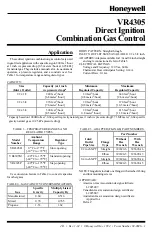
69-0696—1
6
4. If the desired outlet gas pressure or gas flow rate can
not be achieved by adjusting the gas control, check the gas
control inlet pressure by using a manometer at the inlet
pressure tap. If the inlet pressure is in the normal range
(refer to Table 5 or 6), replace the gas control. Otherwise,
take the necessary steps to provide proper gas pressure to
the gas control.
Step-Opening Pressure Regulator
1. The gas control outlet pressure should match the
manifold pressure listed on the appliance nameplate.
2. With the main burner operating, check the gas con-
trol flow rate by using the meter clocking method or check
the gas pressure by using a manometer connected to the gas
control outlet pressure tap. Refer to Fig. 4.
3. If necessary, adjust the pressure regulator to match
the appliance rating. Refer to Table 5 or 6 for factory set
nominal outlet pressures and adjustment ranges.
a. Remove the pressure regulator adjustment cap screw.
b. Using a screwdriver, turn the inner adjustment screw
clockwise
to increase or counterclockwise
to decrease the main burner gas pressure.
c. Always replace the cap screw and tighten firmly to
safeguard proper operation.
4. If desired outlet pressure or flow rate can not be
achieved by adjusting the gas control, check the inlet pres-
sure by using a manometer at inlet pressure tap or upstream
of the gas control. If the inlet pressure is in the normal range
(refer to Table 5 or 6), replace the existing gas control.
Otherwise, take the necessary steps to provide proper gas
pressure to the gas control.
5. Carefully check main burner lightoff at the step
pressure. Make sure the main burner lights smoothly and
without flashback to the orifice and that all ports remain
lit. Cycle the main burner several times, allowing at least
30 seconds between cycles for the regulator to resume the
step function. Repeat after allowing main burner to cool.
Readjust the full rate outlet pressure, if necessary, to im-
prove lightoff characteristics.
CHECK SAFETY SHUTDOWN PERFORMANCE
WARNING
FIRE OR EXPLOSION HAZARD
CAN CAUSE PROPERTY DAMAGE,
SEVERE INJURY, OR DEATH
Perform the safety shutdown test anytime work is
done on a gas system.
NOTE: Read steps 1 through 7 below before starting and
compare to the safety shutdown or safety lockout tests
recommended for the direct ignition (DI) module. Where
they differ, use the procedure recommended for the
module.
1. Turn off gas supply.
2. Set the thermostat or controller above room tem-
perature to call for heat.
3. Watch for ignition spark or for glow at hot surface
igniter either immediately or following prepurge. See DI
module specifications.
4. If module has timed ignition, time the length of the
igniter operation. See DI module specifications.
5. After the module locks out, open gas control knob
and make sure there is no gas flow to the main burner.
6. Set the thermostat below room temperature and wait
one minute.
7. Operate system through one complete cycle to make
sure all controls operate properly.
Outlet Pressure
Nominal Factory
Outlet Setting
Adjustment
Setting Range
Model
Type of
Gas
Nominal Inlet
Pressure Range
Step
Full
Rate
Step
Full
Rate
Standard-,
Natural
1.2 - 1.7
—
0.9
—
0.7 - 1.2
Slow-opening
LP
2.9 - 3.9
—
2.7
—
2.0 - 3.0
Step-opening
Natural
1.2 - 1.7
0.2
0.9
—
0.7 - 1.2
LP
2.9 - 3.9
0.9
2.7
—
2.0 - 3.0
TABLE 6—PRESSURE REGULATOR SPECIFICATION PRESSURES IN kPa.
Outlet Pressure
Nominal Factory
Outlet Setting
Adjustment
Setting Range
Model
Type of
Gas
Nominal Inlet
Pressure Range
Step
Full
Rate
Step
Full
Rate
Standard-,
Natural
5.0 - 7.0
—
3.5
—
3.0 - 5.0
Slow-opening
LP
12.0 - 14.0
—
10.0
—
8.0 - 12.0
Step-opening
Natural
5.0 - 7.0
0.9
3.5
—
3.0 - 5.0
LP
12.0 - 14.0
2.2
10.0
—
8.0 - 12.0
TABLE 5—PRESSURE REGULATOR SPECIFICATION PRESSURES IN INCHES WC.








